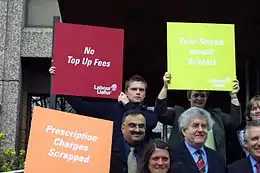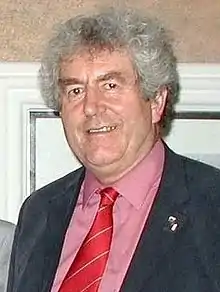Welsh Labour
Welsh Labour (Welsh: Llafur Cymru) is the branch of the United Kingdom Labour Party that operates in Wales. It is the largest and most successful political party in modern Welsh politics. With its predecessor organisations, it has won the biggest share of the vote at every UK General Election since 1922, every Senedd election since 1999, and each European Parliament election from 1979 until 2004, as well as the 2014 one.[7] Welsh Labour holds 22 of 40 Welsh seats in the UK Parliament, 29 of 60 seats in the Senedd, and 576 of 1,264 principal local authority councillors, including overall control of 10 of 22 Welsh local authorities.
Welsh Labour Llafur Cymru | |
|---|---|
| Leader | Mark Drakeford |
| Deputy Leader | Carolyn Harris |
| General Secretary | Louise Magee |
| Founded | 1947 |
| Headquarters | 1 Cathedral Road Cardiff CF11 9HA |
| Student wing | Welsh Labour Students |
| Membership (2018) | 25,000[1] |
| Ideology | Social democracy[2] Democratic socialism[3] British unionism[4] Pro-Europeanism[5] |
| Political position | Centre-left |
| National affiliation | Labour Party (UK) |
| European affiliation | Party of European Socialists |
| International affiliation | Progressive Alliance Socialist International (observer) |
| Colours | Red |
| House of Commons | 22 / 40 (Welsh seats) |
| Senedd Cymru | 28 / 60 |
| Local government in Wales[6] | 454 / 1,253 |
| Police and Crime Commissioners | 2 / 4 |
| Website | |
| www | |
Structure
Welsh Labour is formally part of the Labour Party. It is not separately registered with the Electoral Commission under the terms of the Political Parties, Elections and Referendums Act.[8] In 2016, the Labour Party Conference voted for the office of leader of Welsh Labour to exist; as such, Mark Drakeford is now leader of Welsh Labour.[9] Welsh Labour has autonomy in policy formulation for those areas now devolved to the Senedd, and in candidate selection for it. Party objectives are set by the Welsh Executive Committee (WEC), which plays a similar function to the Labour Party's National Executive Committee (NEC) in devolved responsibilities.
The Welsh Executive Committee is made up of representatives from each section of the party - government, MPs, MSs, MEPs, councillors, trade unions and Constituency Labour Parties (CLPs – the basic unit of organisation throughout the Labour Party). Each of Wales's 40 CLPs is registered as accounting units with the Electoral Commission.[10]
The party's headquarters in Cardiff organise the party's election campaigns at all levels of government (Community Councils, Unitary Authorities, the Senedd and Westminster, support the CLPs and branches in membership matters and perform secretarial functions to the National Assembly Labour Party (NALP) and the party's policy-making process. They also organise the annual conference (the sovereign decision-making body of the party), provide legal and constitutional advice, and arbitrate on certain disciplinary matters.
History
Beginnings
Keir Hardie, the first leader of the Independent Labour Party, was elected as member for Merthyr Tydfil in 1900, and when the National Union of Mineworkers affiliated to the party in 1908, their four sponsored Welsh MPs became Labour MPs.[11] Over the next few years there was a steady increase in the number of Labour councillors and MPs in Wales, and in 1922, Labour won half the Welsh parliamentary seats – setting the scene for the party's hegemony in Welsh politics over subsequent decades.[11]
Efforts were made as early as 1911 to establish a Welsh version of the Independent Labour Party. It was not until May 1947, with the merger of the South Wales Regional Council of Labour and the constituency parties of north and mid-Wales, that an all-Wales unit of the Labour Party was formed, initially called the Welsh Regional Council of Labour. Among those active in North Wales was David Thomas, who helped to found Caernarfonshire Labour Council in 1912 and the North Wales Labour Council in 1914.
The new organisation reflected the consolidation of industrial and trade union power under Clement Attlee's 1945–1951 government. The depression of the 1930s, which had hit Welsh industry particularly hard, led Labour to propose that the Welsh economy be planned and structured on a national basis. An all-Wales party structure was created accordingly. Ironically, the commensurate changes in the machinery of government were not implemented until much later, reflecting a persistent ambivalence within Labour on "the National question".
Welsh Labour's predecessors bequeathed it a formidable electoral inheritance on which to build further. The 1945 General Election won the party 25 of the 36 Welsh constituencies, gaining some 58 per cent of the popular vote. Despite swings away from Labour in the 1950 and 1951 general elections in Britain as a whole, Welsh Labour gained seats and vote share, by extending its appeal from its industrial base in the south and north-east of Wales into the rural and Welsh-speaking areas where the Liberal Party remained strong.
1950s
Though Labour remained in opposition throughout the 1950s, Welsh Labour polled over 50 per cent the popular vote at each general election, winning seemingly impregnable majorities in south-Wales valleys. Aneurin Bevan, for example, was routinely returned for Ebbw Vale with 80 per cent of the vote. The pattern was similar in some 15 other seats in the area. Welsh Labour showed by its actions in local government and its proposals for central government to be a modernising party committed to investment in infrastructure, serious about providing jobs and improving public services.[12]
1960s
In the 1964 general election Welsh Labour polled some 58 per cent of the Welsh vote and won 28 seats. The Wilson government gave Welsh Labour the chance to enact its promise (galvanised by the Conservative Party government's appointment of a Minister of Welsh Affairs in the mid-1950s) to create the post of Secretary of State for Wales and a Welsh Office. The pattern of hegemony seemed set to continue into the 1960s. At the 1966 General Election Welsh Labour's share topped 60 per cent, gaining all but four of Wales's 36 parliamentary constituencies. Within three months, however, Gwynfor Evans sensationally captured Carmarthen for Plaid Cymru at a by-election and his party came within a whisker of victory at the 1967 Rhondda West and 1968 Caerphilly by-elections, achieving swings against Labour of 30 and 40 per cent respectively.
1970s
The emergence of Plaid Cymru (and the Scottish National Party) prompted the Wilson government to establish the Kilbrandon Commission, causing Welsh Labour to consider once more the case for devolution – this time in its favour. Labour victory in the February 1974 General Election pushed devolution onto the political agenda, culminating in a decisive vote against a Welsh Assembly in the 1979 referendum.
The Plaid Cymru threat to the party's industrial heartland fell away in the 1970s, but both it and the Conservatives gained ground in Welsh-speaking and coastal Wales respectively, where Labour's roots were more shallow. By the 1979 General Election Welsh Labour held 22 of the 36 Parliamentary seats, albeit with a 48 per cent vote share.
1980s
This relative decline was eclipsed by a dramatic fall in Labour support at the 1983 General Election. In contrast to the 1950s, the swing against Labour in Britain was matched in Wales, where voters showed themselves just as unwilling to endorse Michael Foot's markedly more left-wing manifesto. Welsh Labour polled a mere 37.5 per cent of the popular vote, yielding 20 seats. A rampant Conservative Party, by contrast, captured 14 seats (including three of the four Cardiff constituencies) and exceeded 30 per cent of the vote for the second election in succession. Welsh Labour's problems were compounded by a strong SDP-Liberal Alliance performance, gaining 23 per cent of the vote (though few seats) at what was to be the height of its success.
The miners' strike of 1984–1985 appeared to present Welsh Labour with an electoral opportunity, despite the invidious position in which it placed the new Labour leader, Neil Kinnock. At the 1987 General Election the Welsh party polled 45 per cent, winning 24 seats, winning another two from the Conservatives at by-elections in 1989 and 1991.
1990s
Equally, however, Conservative policy in Wales could also be said to have helped break the traditional compact between Welsh Labour and the Welsh electorate. The party was shown to be ineffective in the face of the psychologically traumatic restructuring and de-industrialisation of the Welsh economy. Meanwhile seemingly perpetual Conservative rule, on the basis of their electoral power outside Wales, re-ignited debate within Welsh Labour about devolution.[13]
Under John Smith, Labour committed itself to devolution for Wales and Scotland, a commitment that survived his early death. By 1997, Welsh Labour captured 34 of Wales's 40 seats, wiping out the Conservatives' Welsh representation and polling 55 per cent. The stage was set for another devolution referendum, this time won by the narrowest of margins.
Devolution era (from 1999)
Less than two years later, at the first elections to the new Welsh Assembly, Labour was again humbled in its heartlands by Plaid Cymru, losing such totemic seats as Islwyn, Llanelli and Rhondda, though still winning the largest number of seats. In the run-up to the elections, the party's nominee for First Secretary, Ron Davies, had been forced to resign amid an alleged sex scandal. His replacement, Alun Michael, the new Secretary of State for Wales, was seen as a reluctant participant despite an equivalent commitment to Welsh devolution. He was also spoken of as a candidate for the UK leadership of the Labour Party. Labour in Wales won 28 of the 60 seats (20 being allocated via the Additional Member System) on 37 per cent of the vote and a month later came within 2.5 percentage points of being pushed into second place for popular share by Plaid Cymru in elections to the European Parliament.

As in the 1970s, the Nationalist challenge fell away, due in part to the replacement in 2000 of Alun Michael by Rhodri Morgan. Under Morgan's leadership, a coalition was formed with the Liberal Democrats that arguably brought a degree of stability to the administration. By 2003 Labour's share had risen to 40 per cent on a marginally increased turnout and the party gained 30 seats overall, allowing it to govern alone once more. In the 2005 General Election, the party's share fell back to 43 per cent or 29 seats, with the Conservatives regaining a Parliamentary foothold in Wales.
Rhodri Morgan's administration emphasised a difference in approach to public service provision from Tony Blair's government. This collaborative approach contrasted with that of the Blair government's focus on introducing competition in public services, which Morgan argued placed insufficient emphasis on equality of outcome.[14] In practice, this meant foregoing many policies of the Westminster Labour government, such as foundation hospitals, school academies and PFI projects in some areas. Other noted initiatives in Wales included free school breakfasts, free access to swimming pools for children in school holidays, and abolition of medical prescription fees.[15] However, the party faced criticism for seemingly backing away from a manifesto commitment to scrap home-care charges for the disabled.
In the 2007 elections Welsh Labour's share of the vote fell to 32.2 per cent, its second lowest since the UK General Election of 1923. Its number of seats fell by four (on 2003) to 26: 11 more than the second largest party, Plaid Cymru. On 25 May Rhodri Morgan was again nominated as First Minister. On 27 June, Morgan concluded the One Wales agreement with Plaid Cymru, which was approved by the Labour rank and file on 6 July. On 1 December 2009, Carwyn Jones became the new leader of Welsh Labour.[16]
In March 2010 Welsh Labour twice refused to cross the PCS union picket line, Carwyn Jones arguing that such a refusal was ingrained in Labour's thinking. This led to strong criticism for not doing so from the Welsh Conservative Party and the Welsh Liberal Democrats.[17]
On 6 May 2016 Welsh Labour won 29 of the 60 seats in the Assembly elections and secured a fifth term in government in a minority coalition with the sole remaining Welsh Liberal Democrat Kirsty Williams member.
Electoral performance
In recent years there has been some decline for Labour in Wales. For the first time since 1918, the Conservatives came first in an election in Wales (the 2009 European Parliament election) and in the 2010 general election Labour had its worst general election result in Wales in its history. If the swing in Wales were repeated across the UK, the Conservatives would have won a landslide victory of over 100 seats; in some, such as Pontypridd, Welsh Labour lost over 16 per cent of its vote. In the 2011 Welsh Assembly elections, Labour regained half of the seats in the National Assembly. In the 2014 European Parliament elections, Labour topped the poll in Wales with a swing of 7.9 percentage points.
In the 2017 general election, the decline in parliamentary elections was reversed – Labour raised its vote share to 48.9 per cent, its highest in a general election in Wales since 1997, winning 28 of the 40 Welsh seats in Westminster.
European Parliament elections
| Year | Percentage of votes | Seats won |
|---|---|---|
| 1979 | 41.5% | 3 / 4 |
| 1984 | 44.5% | 3 / 4 |
| 1989 | 48.9% | 4 / 4 |
| 1994 | 55.9% | 5 / 5 |
| 1999 | 31.8% | 2 / 5 |
| 2004 | 32.5% | 2 / 4 |
| 2009 | 20.3% | 1 / 4 |
| 2014 | 28.1% | 1 / 4 |
| 2019 | 15.3% | 1 / 4 |
UK general elections
| Year | Percentage of votes | Seats won |
|---|---|---|
| 1945 | 58.5% | 25 / 35 |
| 1950 | 58.1% | 27 / 36 |
| 1951 | 60.5% | 27 / 36 |
| 1955 | 57.6% | 27 / 36 |
| 1959 | 56.4% | 27 / 36 |
| 1964 | 57.8% | 28 / 36 |
| 1966 | 60.7% | 32 / 36 |
| 1970 | 51.6% | 27 / 36 |
| 1974 (Feb) | 46.8% | 24 / 36 |
| 1974 (Oct) | 49.5% | 23 / 36 |
| 1979* | 48.6% | 22 / 36 |
| 1983 | 37.5% | 20 / 38 |
| 1987 | 45.1% | 24 / 38 |
| 1992 | 49.5% | 27 / 38 |
| 1997 | 54.8% | 34 / 40 |
| 2001 | 48.6% | 34 / 40 |
| 2005 | 42.7% | 29 / 40 |
| 2010 | 36.3% | 26 / 40 |
| 2015 | 37.1% | 25 / 40 |
| 2017 | 48.9% | 28 / 40 |
| 2019 | 40.9% | 22 / 40 |
* Includes the Speaker.
Senedd elections
| Year | Percentage of votes | Seats won | Government | |||
|---|---|---|---|---|---|---|
| Constituencies | Regional lists | Constituencies | Regional top-up seats | Total | ||
| 1999 | 37.6% | 35.5% | 27 / 40 | 1 / 20 | 28 / 60 | Coalition Lab–LD |
| 2003 | 40.0% | 36.6% | 30 / 40 | 0 / 20 | 30 / 60 | Government |
| 2007 | 32.2% | 29.7% | 24 / 40 | 2 / 20 | 26 / 60 | Coalition Lab–Plaid |
| 2011 | 42.3% | 36.9% | 28 / 40 | 2 / 20 | 30 / 60 | Government |
| 2016 | 34.7% | 31.5% | 27 / 40 | 2 / 20 | 29 / 60 | Coalition Lab–LD |
Elected leaders
| Portrait | Leader | From | To | |
|---|---|---|---|---|
| 1 |  |
Ron Davies | 19 September 1998[18] | 29 October 1998 |
| 2 |  |
Alun Michael | 20 February 1999 | 9 February 2000 |
| 3 |  |
Rhodri Morgan | 9 February 2000 | 1 December 2009 |
| 4 | .jpg.webp) |
Carwyn Jones | 1 December 2009 | 6 December 2018 |
| 5 | .jpg.webp) |
Mark Drakeford | 7 December 2018 | Incumbent |
Elected deputy leaders
| No. | Image | Name | Term start | Term end |
|---|---|---|---|---|
| 1 |  | Carolyn Harris | 21 April 2018 | Incumbent |
General secretaries
- 1947: Cliff Prothero
- 1965: Emrys Jones
- 1979: Hubert Morgan
- 1984: Anita Gale
- 1999: Jessica Morden
- 2005: Chris Roberts
- 2010: David Hagendyk
- 2017: Louise Magee
References
- Davies, Daniel (9 November 2018). "Welsh Labour leadership: Do people know the candidates?". BBC News Online.
- Nordsieck, Wolfram (2016). "Wales/UK". Parties and Elections in Europe. Retrieved 9 October 2018.
- dams, Ian (1998). Ideology and Politics in Britain Today (illustrated, reprint ed.). Manchester University Press. pp. 144–145. ISBN 9780719050565. Retrieved 21 March 2015.
- "Standing up for Wales - Welsh Labour Manifesto 2019" (PDF). Retrieved 2020-07-31.
- "Standing up for Wales - Welsh Labour Manifesto 2019" (PDF). Retrieved 2020-07-31.
- "Open Council Data UK - compositions councillors parties wards elections". www.opencouncildata.co.uk. Retrieved 2019-10-24.
- B. Jones, Welsh Elections 1885–1997 (1999), Lolfa. See also UK 2001 General Election results by region, UK 2005 General Election results by region, 1999 Welsh Assembly election results, 2003 Welsh Assembly election results and 2004 European Parliament election results in Wales (BBC).
- "www.electoralcommission.org.uk/regulatory-issues/regpoliticalparties.cfm?frmGB=1&frmPartyID=6&frmType=partydetail". electoralcommission.org.uk. Retrieved 27 November 2017.
- "Labour backs more autonomy for Welsh party | Wales – ITV News". itv.com. Retrieved 27 November 2017.
- "www.electoralcommission.org.uk/regulatory-issues/regpoliticalparties.cfm?frmPartyID=6&frmType=audetail". electoralcommission.org.uk. Retrieved 27 November 2017.
- The Welsh Academy Encyclopedia of Wales. Cardiff: University of Wales Press 2008
- A. Walling, "The Structure of Power in Labour Wales 1951–1964" in The Labour Party in Wales 1900-200, ed. D. Tanner, C. Williams and D. Hopkin, 2000, University of Wales Press.
- D. Tanner, "Facing the New Challenge: Labour and Politics 1970–2000", The Labour Party in Wales 1900–2000, ed. D. Tanner, C. Williams and D. Hopkin, 2000, University of Wales Press.
- Speech by Rhodri Morgan, "Public Services: Looking to the future for Wales", 7 October 2004. See also Speech to the National Centre for Public Policy, University of Wales Swansea, December 2002
- "BBC NEWS - UK - Wales - AMs vote for free prescriptions". Retrieved 8 May 2015.
- "BBC News - Jones is new Welsh Labour leader". Retrieved 8 May 2015.
- "BBC News - Labour, Plaid AMs to miss debate due to picket line". Retrieved 8 May 2015.
- "BBC News - Davies beats off backbench challenge". Retrieved 2 November 2018.